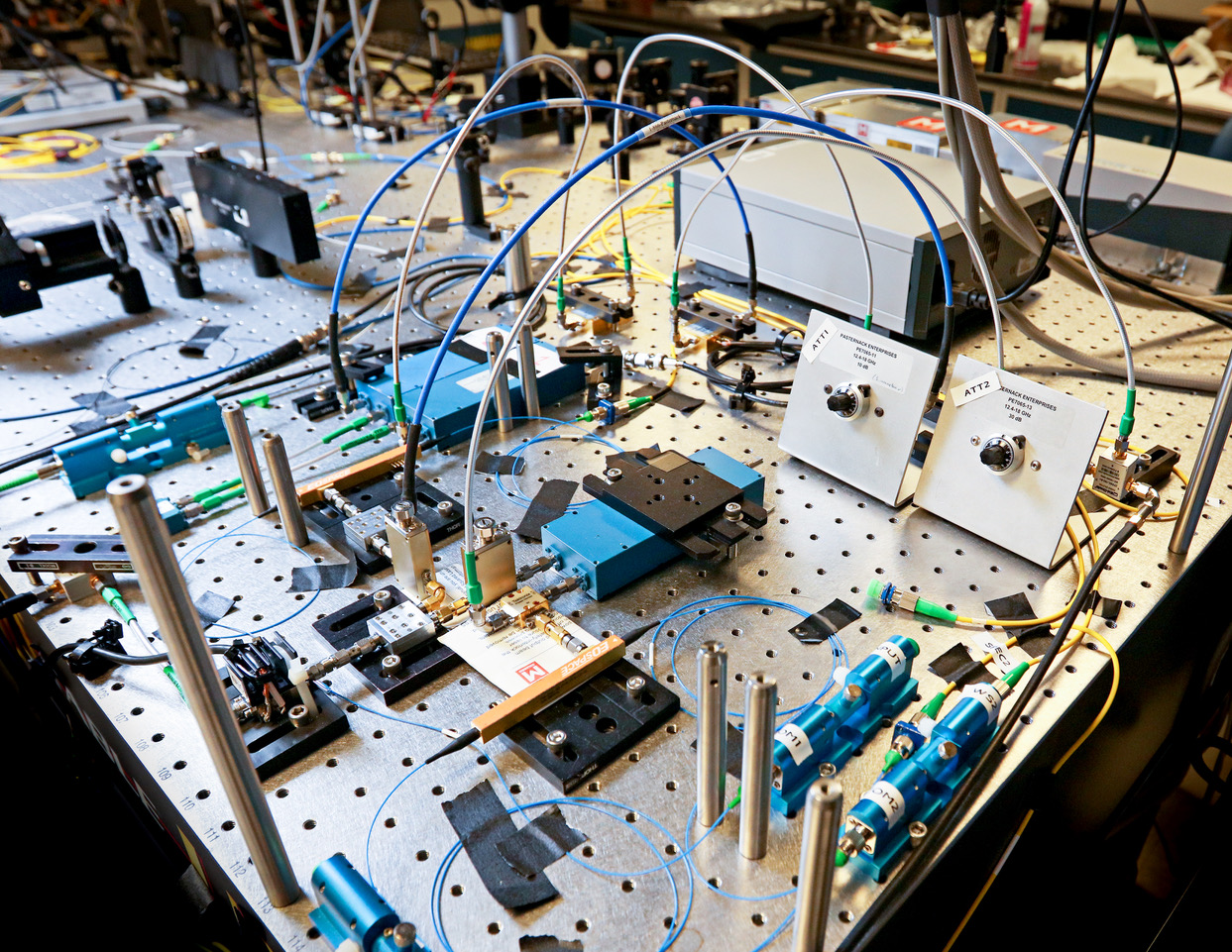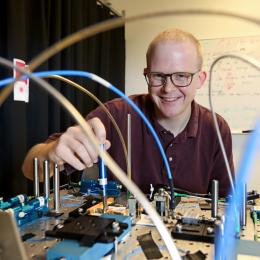For the past decade, Joseph Lukens has pushed the boundaries of manipulating light in photonic communications. While a Ph.D. student in electrical engineering at Purdue University, he co-discovered a way to hide data in an optical fiber stream of billionth-of-a-second, variously shaped light-wave pulses. The 2013 research received global media coverage as a Harry Potter-esque photonic invisibility cloak. Now the research with the Department of Energy’s (DOE) Oak Ridge National Laboratory is extending his growing mastery of photons not to hide data but share it in a future quantum internet.
“The field of quantum information is poised to unleash a revolution in how we collect, process and secure information,” says Lukens, a researcher in ORNL’s Computational Sciences and Engineering Division since 2015. “Photons represent the best, and realistically, the only quantum particles capable of serving as flying qubits, or carriers of quantum information across significant distances.”
His vision, outlined in a 50-page proposal entitled “Scalable architectures for hybrid quantum/classical networking,” is remarkable for its stepwise approach to using advanced classical photonics technologies to create the nodes for such a system. The proposal calls for harnessing the existing vast fiber-optic communications infrastructure, including DOE’s Energy Sciences Network, better known as ESnet and based at Lawrence Berkeley National Laboratory. In this way both old and new technological approaches (classical and quantum) will use the same information highway, just as now internal combustion vehicles share the road with advanced electric autos.
“My M.O. to this point is to take ideas that seem kind of crazy but then leverage technology that people have worked hard to develop and refine in other fields and apply it to these new areas,” says Lukens, an ORNL Wigner Fellow. The designation is particularly apt: Nobel Laureate Eugene Wigner, the lab’s first director, developed the mathematical underpinnings of quantum calculations. Lukens is turning this math into next-generation quantum technologies.
Lukens pursues this technological roadmap with support from the DOE Office of Science Advanced Scientific Computing Research program as a 2019 Early Career Award recipient.
Quantum information processing, including quantum computers, uses what have been considered the strange aspects of quantum behavior of matter and light to create uniquely powerful sensing, computation and information-security technologies. For example, while a standard bit in computer technology can represent either zero or one, a quantum bit, or qubit, can exist in a superposition of both zero and one simultaneously. As a result, qubits can perform computations impossible on a classical computer.
But qubits are notoriously difficult to control. Measure a qubit – as is done routinely on classical bits in photonic signal processing – and you destroy its fragile quantum state.
“This means that we have to come up with fundamentally new ways to realize quantum networking, because you can’t just digitally connect quantum computers like you can classical computers,” Lukens says.
One key hurdle: A quantum internet must be capable of quantum information translation into a common universal language, or protocol. This is because the various quantum computer technologies now in development use a variety of qubit types, for example ions and superconductors, that operate at distinct frequencies. Thus, one of the major roadblocks to imagining a universal quantum network is that it must be able to encode and transmit qubits with mismatched properties.
Lukens has co-discovered a solution to this problem using a novel quantum light manipulation technique to create frequency-encoded qubits. And during the past three years, he and colleagues have taken the idea from theory to experimental demonstration and now to chip-based prototype technologies.
‘You can control the photonic qubits without damaging the quantum information.’
First, in a frequently cited 2017 paper in Optica, Lukens and ORNL colleague Pavel Lougovski described the theoretical groundwork for how frequency-encoded qubits could act as a bridge between diverse quantum systems, turning frequency mismatch into a strength. In classical photonics, wavelength division multiplexing is the transformative technology in which multiple wavelengths of light can all be sent down an optical fiber at the same time, thus packing in much more data. Each wavelength (or frequency, a different measure of the same physical property of light) occupies a different lane in the optical fiber.
“Our frequency-encoded qubit approach is built on operations like a frequency beam-splitter,” Lukens says. In this case, photons exist in superposition of two frequency bins, or wavelengths, as the qubit zero and one states. Just as a traditional beam splitter can divide a laser beam in two or, conversely, combine two beams into one, a frequency beam splitter interferes the two colors of a frequency-encoded photon in a controllable way – all in optical fiber.
In a follow-up experiment at ORNL, Lukens, Lougovski and Purdue colleagues, including Lukens’s former thesis advisor and now collaborator Andrew Weiner, used this technique to successfully demonstrate a setup for a quantum frequency processor (QFP), or control tool, to effectively manipulate qubits.
The QFP uses two types of off-the-shelf photonics components. First, an electro-optic phase modulator uses radio-frequency pulses to encode information into a stream of photons by shifting their phases. Then, a Fourier-transform pulse shaper acts to both route and adjust the content of the individual frequency bins.
“The discovery that made all this possible was when we realized that if you take these two devices and alternate them in series, you can control the photonic qubits without damaging the quantum information,” Lukens says. “The hard thing to do is to get these frequencies to mix with each other in a controllable way, so that’s why the frequency beam splitter ended up being so important and so foundational for us in really driving this idea forward.”
Though a quantum/classical hybrid internet is years away, Lukens is moving relentlessly toward his goal, with the next step transferring the QFP, until now a table-top setup, onto a silicon chip.
“This is critical because it makes the system practical and scalable,” he says.
The team has transferred the QFP to silicon and is beginning to test the first prototypes from “eight-inch wafers where we have a little chunk of our quantum frequency processor on it,” produced with support from colleagues at the Air Force Research Laboratory in Rome, New York.
The next stage in Lukens’s journey at the frontiers of manipulating light is building a quantum/classical hybrid local area network – one small step toward a quantum internet.
“Rather than just doing things on the tabletop,” Lukens says, “I want to connect multiple labs and demonstrate new quantum protocols in real-world settings.”


